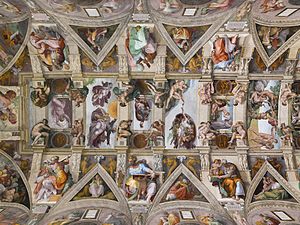Ceiling painting
Under ceiling paintings (also painted ceiling , the ceiling , ceiling painting ) refers to the painting ( amended ) from ceilings or vaults in sacred and profane interiors.
General
The ceiling painting, like its counterpart on vertical surfaces, the wall painting , has been known since ancient times . In the absence of other equally durable colors, the colors were mainly applied using the al fresco technique until the 20th century , in which the pigments silicified with the still moist plaster substrate in a chemical reaction and thus retained their color for a long time. In addition, the Secco technique was also used. In the fresco-secco , also known as dry painting (from the Italian secco : on dry land ), is a technique in which the colors are applied to the already dry masonry. In the Middle Ages, mainly lime, casein and tempera paints were used, later also oil and silicate paints. This technique was used most often in the Romanesque period (around 1000–1200 AD). Even with today's designs, the paint is almost exclusively applied al secco , with acrylic paints being preferred .
Scaffolding was erected for the plasterers and painters to carry out ceiling frescoes. The artist usually used stencils or 1: 1 templates that were perforated in order to transfer the contours with colored powder. The work was done in day works (= the work to be created by the artist in one day), each of which was prepared with a fresh layer of plaster. If the artist couldn't do the day's work, the remaining layer of plaster had to be removed and reapplied the next day.
This relatively cumbersome procedure was viewed by many painters as a hindrance and gave rise to numerous attempts to improve the durability with new color mixtures.
An intermediate position is taken by pictures that were painted on wood or canvas but were intended from the outset to be attached to a ceiling.
middle Ages

In the Middle Ages, were for painting wood coffered ceilings also tempera - and oil colors used, while paintings were applied to plaster in different mixing techniques. In addition to stories from the Old and New Testament, the usual topics were also floral and geometric ornaments , coats of arms , symbols of status, animal allegories, etc. The representation of the objects was not central - but with a perspective of meaning , flat and parallel to the ceiling.
Renaissance

The heyday of ceiling painting on vaulted and architecturally structured ceiling surfaces began in the Renaissance and finally reached its climax in the Baroque period . The central perspective method of representation, rediscovered since Giotto di Bondone , Masaccio and Andrea Mantegna , described mathematically by Piero della Francesca and perfected by the great painters of the Italian Renaissance, allowed the artists to construct a perfect illusionistic pictorial space. Fantastic worlds arose on the ceilings of baroque churches with their apotheoses of saints of the Catholic Church, which should fill the viewer with astonishment and devotion. The space-enclosing effect of the real ceiling seemed to be suspended, and the viewer's gaze was drawn to an illusionistic space beyond the ceiling ( trompe-l'oeil ). An example of this is the ceiling painting in the marble hall in Melker Stift , a joint work by Gaetano Fanti (painting of pseudo-architecture) and Paul Troger (painting of the opening of the sky).
This invention of images was adopted for the ceiling paintings in representative rooms of princely residences. The first such example is the ceiling painting in the Palazzo Pitti with the apotheosis of Duke Cosimo I de 'Medici , who is seated on a throne on clouds, he is dressed in antique armor, and Flora crowns him with a diadem.
Probably the most famous ceiling painting is the ceiling of the Sistine Chapel in the Vatican, painted by Michelangelo (Buonarroti) between 1508 and 1512 on behalf of Pope Julius II . It was unveiled on November 1st, 1512 and shows scenes from Genesis on a total of 520 m² with 115 larger than life figures. An excerpt from " The Creation of Adam ", reproduced countless times, shows God the Father bringing Adam to life with an outstretched finger . Michelangelo's picture is still considered a prime example of ceiling painting.
Classicism, historicism
In contrast to the Rococo at the same time, the illusionistic ceiling painting no longer plays a role in classicism . An example here is the picture of Parnassus by Anton Raphael Mengs in the Villa Albani in Rome, in which Mengs completely dispenses with the creation of an illusionistic space. Sacred and secular buildings of historicism are still based on the models of the Renaissance and Baroque, as shown by the great opera houses of the 19th century in Paris, Vienna or the Dresden Semperoper .
literature
in alphabetical order by authors / editors
- PW Hartmann: The great art dictionary. ( kunstlexikon.faz.net ).
- Bernd Wolfgang Lindemann: Pictures from Heaven. Studies of ceiling painting in the 17th and 18th centuries. Wernersche Verlagsgesellschaft, Worms 1994, ISBN 3-88462-101-7 .
- Hans-Herbert Möller : Restoration of cultural monuments. Examples from the preservation of monuments in Lower Saxony = reports on the preservation of monuments Supplement 2. Niemeyer, Hameln 1989, ISBN 3-87585-152-8 , pp. 191-260.
- Graham Rust: The Painted Ceiling. Constable-Verlag, ISBN 1-84119-310-0 .
- Sylva Scheglmann : Attempt at a history of the development of ceiling painting in Italy from the 15th to the 19th century. Strasbourg 1910 ( archive.org ). Reprinted 2009, ISBN 978-1-116-62687-2 .
Web links
- Bavarian Academy of Sciences: The project: Corpus of baroque ceiling painting in Germany (CbDD). In : deckemalerei.badw.de. Retrieved March 17, 2016 .

